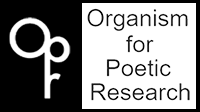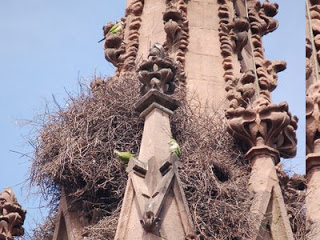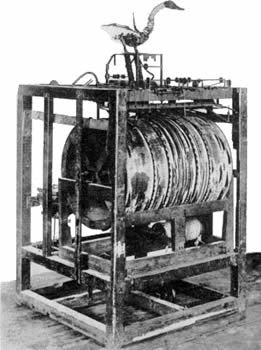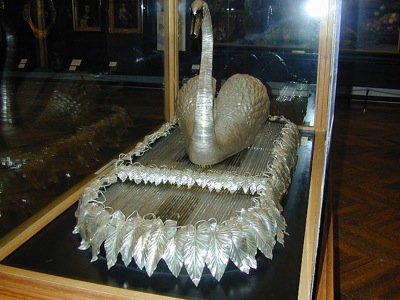From Parrow, a Poetic Ethology
“‘Snark’ is a portmanteau word which designates a fantastic or composite animal, shark + snake… It connotes a series of the animal or vegetable provenance of edible and denotable objects and a series of verbal proliferation of expressible senses.”
– Gilles Deleuze, The Logic of Sensei
Natural History
It may seem strange to see these brightly colored exotic birds in this snowy landscape. Monk parakeets (Myopsitta monachus) originate from the temperate to sub-tropical areas of South America, inhabiting countries such as Brazil or central Argentina, but as one of the few temperate-zone parrots they have been able to survive in cold climates and have formed colonies along the Eastern seaboard. The parakeets at Green-Wood Cemetery escaped in the late 1960s from a large crate in which they were being shipped from Argentina to local pet shops in the New York area. It is rumored that the crate somehow broke open and that the parrots escaped into the environment surrounding John F. Kennedy International Airport, hanging around the Jamaica Bay marshes around JFK’s southern edges before making their way into Brooklyn. They created two major colonies, one at Brooklyn’s Green-Wood Cemetery, which forms a significant green area adjacent to Prospect Park and another just south-east of there on the grounds of Brooklyn College.
The emerging field of animal architecture has sought to investigate the performative role of biology in design. The parakeets have made use of human-made architectural structures and combined them with their own construction of complex collective nests. “Monk parakeets often breed in multi-chambered nests that may contain more than one breeding pair, with each pair and its offspring usually occupying a separate chamber” (Eberhard 1998).ii Nests made of material weighing up to 400 pounds have been recorded. The parakeets have constructed a large nest on the elaborate gothic-revival gate at Green-Wood Cemetery and additional nests on the nearby electrical transformers. The complex elaborations of the surface produced by neo-gothic ornamentations of the gate create a texturally complex environment for the parakeets to inhabit. The parakeets use the many different vertically arranged ornaments on the gate’s spire as little perching platforms
In The Geographical History of America, Gertrude Stein writes: “When children play tag they tag each other that is they touch each other to start, well dogs do that, they touch each other to start just as children do. A big dog touches a little dog to start him to play a white dog touches a black dog to start him to play a black dog will touch any dog to start him to play.” What kind of a beginning does Stein’s writing offer for a poetics of ethology?iii
Parrots appear in seventeenth century French philosopher René Descartes’ Discourse on Method as proof that animals act as machines, capable only of automated repetition, rather than possessing the flexibility to generate novel responses or actions. He goes as far as to suggest that “if there had been […] machines, possessing the organs and outward form of a monkey or some other animal without reason, we should not have […] any means of ascertaining that these machines were not of the same nature as those animals”iv In other words, if we saw a very realistic mechanical monkey we would not be able to tell it apart from a real monkey. Following these precepts about the equivalence between animals and machines, in 1739 Jacques de Vaucanson builds the Digesting Duck automaton. This mechanical duck appears to be able to eat kernels of grain, digest them and defecate them, but it is discovered subsequently that the kernels of corn are simply stored in one container, and that the pre-stored feces come out of a different container within the duck’s mechanical body. A little later, in 1773 John Joseph Merlin builds the Silver Swan. The swan and its surrounding environment is a clockwork mechanism, which gives the appearance of a swan floating in a stream of moving water, surrounded by silver leaves. The illusion of a moving stream is generated with the help of rotating glass rods and small silver fish can also be seen swimming in the stream. The swan is capable of turning its head from side to side and preening itself. Every 40 seconds it bends its head downwards and appears to eat one of the silver fish.
Descartes suggests that even though “magpies and parrots” possess vocal organs which allow them to “utter [human] words,” they are “incapable of joining together different words […] to make their thoughts understood”v and they are, in particular, not capable of any spontaneity that would enable them to invent novel signs in novel situations. In other words, Descartes’ parrot, as the common expression goes, is only capable of parroting or repeating mechanically. Descartes warns us specifically that we must not be seduced by ancient philosophers who have suggested that animals may speak, although we do not understand their language. In her 1935 lecture “Portraits and Repetition” Stein writes that if anything is alive, it is not repeating, but continuously varies its insistence.In order to illustrate this statement, she evokes the example of a living organism: “It is very like a frog hopping,” she writes, “he cannot ever hop exactly the same distance or the same way of hopping at every hop. A bird’s singing is perhaps the nearest thing to repetition but if you listen they too vary their insistence.”vi
Field Notes
One parakeet “Light” is visible at the entrance to nest A. “Light” is standing on a metal structure. Another parakeet “Green Side” arrives and rests on the metal structure. The two vocalize. “Light” has his face towards the nest. Another parakeet arrives at the nest to the north. “Green Side” flies away from the initial nest A. At the northern nest a parakeet can be seen resting on a blue metal bar. Two parakeets are now resting on the blue bar. A great deal of vocalization in the nearby trees. Many parakeets are seen underneath the trees. Once again “Green Side” arrives at nest A to rest at the entrance standing on the metal structure. Vocalizations coming from inside of nest A.
Two parakeets “Golden Ears” and “Streaker” arrive at nest B and enter its most northward chamber. They vocalize and then their green tails disappear into the interior. No nest building or nest repair activity is visible. These nests have short and steep eastward edges made for windfall. “Golden Ears” flies out of the nest and lands on a nearby transformer. “Streaker” makes three calls from the interior of the nest. “Golden Ears” turns around on the metal bar. The metal bar is sticking out from a little red house. “Golden Ears” flies back to nest B and vocalizes entering again the interior chamber of the nest. There are parakeets making calls in the nearby pine trees. “Golden Ear” flies out of the nest and overhead across the street to the nearby fir trees, vocalizing. He lands of a fir tree branch, vocalizing. Two sparrows fly into the transmitter enclosure. “Golden Ears” calls out from a nearby fir tree. Once, twice, then a third time. “Golden Ears” is resting in a fir tree, vocalizing. No parakeet activity is visible at the nest. “Golden Ears” makes screeching calls. Green tail fathers are visible sticking out of the nest chamber opening. “Streaker” exits the nest. Another unidentified bird – “Ronny” – exits the nest and flies south. Three starlings enter the transformer enclosure area. There are turquoise spots attractively visible on their necks. “Golden Ears” is still vocalizing in the nearby fir trees. No parakeet activity is now visible at the nest. To swing into these rhythms of their movement. Airplanes fly overhead. Starlings fly overhead. “Golden ears” vocalizes with fast sharp screeching sequences of sounds in the fir trees. “Golden Ears” vocalizes once more and flies east.
No activity is visible at the gothic gate nest. The openings leading to the nest chambers are dark. A single parakeet vocalization in the air to the right. Then a series of high-pitched vocalizations at the nest. Three parakeets fl y off in a streaming line one after another. It is a relay, a sequence of touch and release. Five small brown birds arrive at the nest. A parakeet “Varnish” exits the nest, vocalizes twice, and flies east. There is s smell of fresh baked pretzels in the air. The branches shake in the sound of the open wind. No parakeets are visible at the nest. The sky moves above the nest. The white sheet of the tent flaps against the concrete. No parakeets are visible at the nest. Far away parakeet vocalizations in the distance to the right. A black hawk with a torn wing flies over the nest. The smell of humans perfumes the ordered sky. No parakeets are visible. The inside of the nest is an invisible unknowing. The animals one is waiting for exist in their own time. The nest is collective, housing tens of pairs of birds. Each entrance is an oval opening nippling out of its surface. Large cumulus clouds move across the sky. The white tunic of the tent flaps in the wind. “Varnish” arrives at the lower right nest entrance and inserts himself upwards into the nest chamber. Loose branches flap in the wind changing the appearance of the nest from an ordered structure to a haphazard pile of twigs. Two parakeets “Lydia” and “Bambi” fl y out of the lower opening at the north face of the nest. They fly in the direction of the electrical transformers. Vocalizations of many parakeets can be heard in the distance. A parakeet “Rhonda” vocalizes and flies out of the lower right nest opening on the north face of the gate nest. More vocalizations can be heard from the nest’s interior. “Bambi” returns with a white, wet-looking morsel in his mouth and rests on the large spherical corner ornament on the south face of the nest.
______
iDeleuze, Gilles. The Logic of Sense. (New York: Columbia UP, 1990), 54.
iiEberhard J. 1998. “Breeding Biology of the Monk Parakeet.” Wilson Bull. 110(4):463-473.
iiiStein, Gertrude. The Geographical History of America or The Relation of Human Nature to the Human Mind. (New York: Random House, 1936), 54.
ivDescartes, René. Discourse on Method and Meditations on First Philosophy. Trans. Elizabeth S. Haldane (Stilwell: Digreads, 2005), 25.
vibid., 26.
viStein, Gertrude. “Portraits and Repetition.” Look at Me Now and Here I Am: Writings and Lectures 1909-45. (New York: Penguin Books, 1971), 100.




